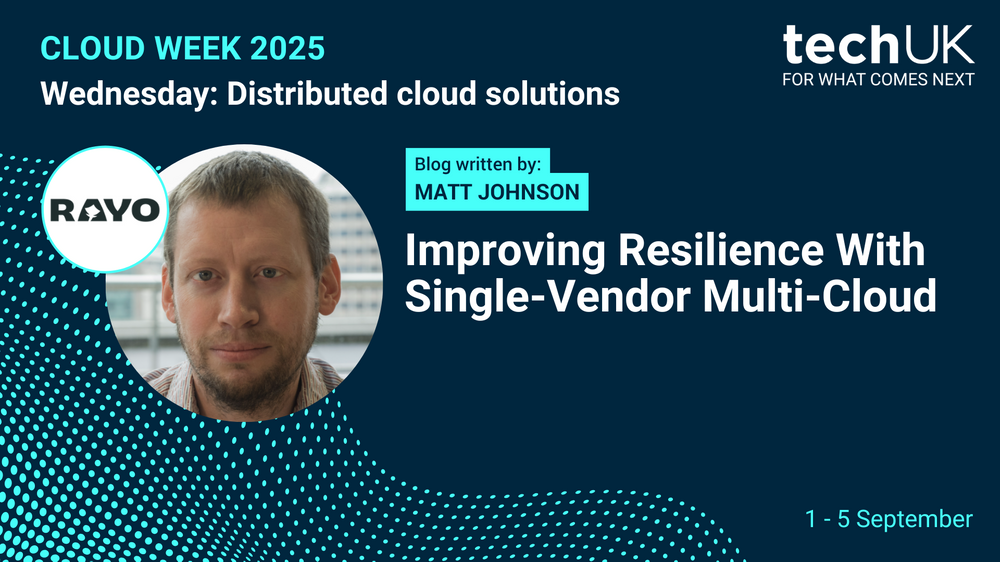Improving resilience with single-vendor multi-cloud (Guest blog from Rayo)

This blog was written by Matt Johnson, CEO, Rayo (A UBDS Group Company)
The Complexity of Traditional Multi-Cloud
Although the term multi-cloud has been around for more than a decade, it’s only in the last couple of years that interest in this approach has really taken off (driven in part by concerns around major security incidents, as well as regulatory concerns). There are lots of reasons why organisations are exploring multi-cloud: to reduce risk, increase resilience, or to avoid vendor lock-in. The theory is compelling; distribute workloads across multiple hyperscale cloud providers and gain the best of each platform while insulating against outages.
In practice, however, multi-cloud has proven extremely complex. Each cloud vendor comes with its own set of skills, certifications, and learning curves. Contracts must be negotiated and managed separately, creating administrative overhead. CI/CD pipelines need to be built and maintained for each environment. Security policies and compliance models differ, often requiring parallel implementations and governance processes. The end result is duplication of effort, steep operational costs, and an increased likelihood of human error.
What Multi-Cloud Really Delivers
Despite the rhetoric, most multi-cloud strategies are not about achieving 100% resilience through active-active architectures. Running a workload live across two or more hyperscalers simultaneously is close to impossible for all but the simplest applications.
Differences in APIs, latency, and service implementations make true cross-cloud failover prohibitively difficult. At best, organisations resort to container-based approaches, forgoing many of the benefits that cloud providers offer; at worst, they spend months (or even years) building out “cloud brokerage” capabilities that invariably fail to deliver, and simply add complexity and cost.
Instead, organisations often use multi-cloud to address softer goals, such as reducing perceived lock-in to a single provider, gaining negotiation leverage, or diversifying critical data storage to hedge against “black-swan” events.
In reality, most resilience advice stops short of full multi-cloud. Cloud providers themselves (at least, the leaders!) have a vested interest against multi-cloud approaches and instead recommend single-vendor multi-region architectures for the highest levels of resilience. By running workloads across separate regions within the same cloud, organisations achieve higher resilience while retaining consistent tooling, processes, and expertise.
Yet even this leaves residual risks, namely the small but real possibility of a “global” cloud outage. If critical control-plane services fail, or a vendor suffers a broad systemic issue, multi-region resilience within one cloud may not be enough.
Enter the Single-Vendor Multi-Cloud
With the upcoming introduction of AWS European Sovereign Cloud (AWS ESC), a new conceptual operating model emerges: single-vendor multi-cloud.
At its core, this leverages the concept of AWS partitions. An AWS partition is a completely isolated collection of AWS regions that does not share underlying control-plane components with other partitions. Today, most customers operate in the global AWS partition, which includes regions such as London, Ireland, Frankfurt, and Oregon, with partitional (or “global”) services mostly hosted in Virginia. The AWS ESC, however, will exist as its own partition – with a separate, sovereign control plane.
That means even if a systemic outage were to occur in the global partition, the AWS ESC partition would remain unaffected. For the first time, customers gain the ability to hedge against global outages without needing to introduce a second cloud provider.
Benefits of Single-Vendor Multi-Cloud
Single-vendor multi-cloud such as the AWS ESC (and with some additional work, on premises equivalents from providers such as Oracle and Google) offer a number of benefits:
- Familiar Tooling and Skills: Unlike traditional multi-cloud approaches, adopting a second AWS partition does not require retraining staff or retooling pipelines. The same APIs, SDKs, monitoring, alerting, and management frameworks work across both the global and AWS ESC partitions – only the API endpoints need to be updated. Teams can reuse existing skills and processes, dramatically lowering the barrier to entry.
- Protection From Global Outages: By leveraging multiple AWS partitions, organisations gain insulation from partition-wide control-plane issues, ensuring that a global outage in one partition does not cascade into another. This approach enables resilience levels once only achievable through multi- cloud but without the heavy duplication costs. Starting with a simple backup environment holding critical data, organisations can evolve incrementally toward advanced strategies like active-active architectures, achieving higher resilience than is possible in a single partition.
- More Complex Than Multi-Region, But Less Than Multi-Provider: There is no denying that single-vendor multi-cloud is more complex than a (relatively) simple multi-region strategy. Data replication, cross-partition orchestration, and architectural design all add layers of challenge. However, compared to operating across two different cloud vendors, the relative simplicity is clear. Organisations gain most of the benefits of traditional multi-cloud at perhaps 20% of the overall cost and effort.
Challenges and Considerations
Of course, single-vendor multi-cloud isn’t without trade-offs. Specifically, complexity increases as data flows and application states need to be synchronised across partitional endpoints. And there remains an upstream dependency on a single vendor. If AWS as a company suffers existential disruption, both partitions are ultimately impacted.
Yet in practice, these risks are acceptable to most organisations. Few enterprises can justify the immense overhead of full multi-cloud, and many would prefer to consolidate skills and vendor relationships. By adding partition-level redundancy, they strike a pragmatic balance between resilience, complexity, and cost.
Conclusion
The launch of AWS ESC and the principle of partition-level redundancy mark a turning point in cloud strategy, enabling meaningful “cross-cloud” resilience within a single ecosystem. By combining multi-region strengths with multi-partition insulation, organisations gain a pragmatic path to resilience that avoids the complexity of traditional multi-cloud. This single- vendor approach delivers most of the resilience benefits without requiring mastery of multiple providers, offering a powerful way to future-proof workloads, guard against global outages, and simplify resilience strategies.
Next steps
At Rayo, we see enormous potential in this model. Our expertise lies in helping both public and private sector organisations architect, implement, and manage these types of cloud architectures. From initial design to ongoing operations, we can guide organisations through all stage of the journey.
If you’re interested in finding out more, then we’d love to hear from you; email us ([email protected]) or reach out to me directly ([email protected])
For more information please contact:





